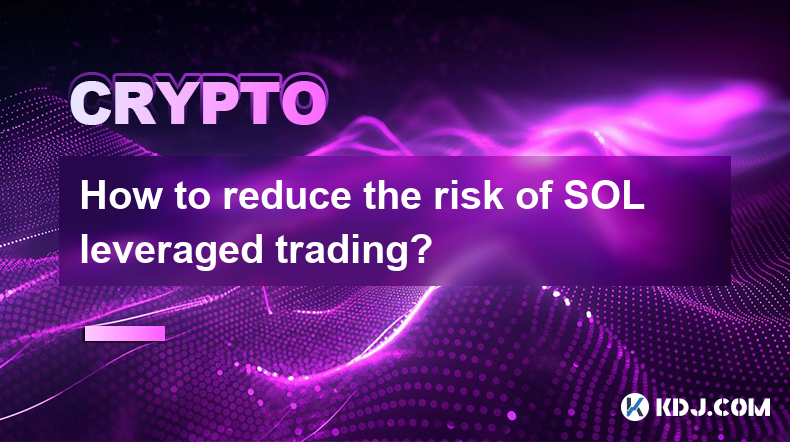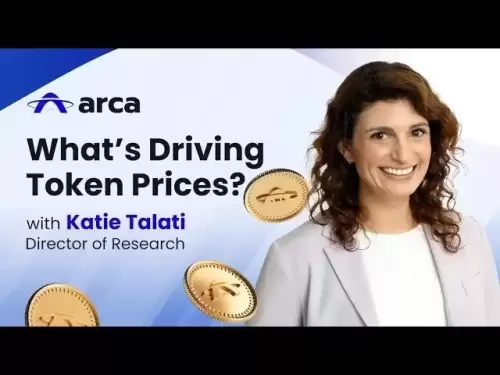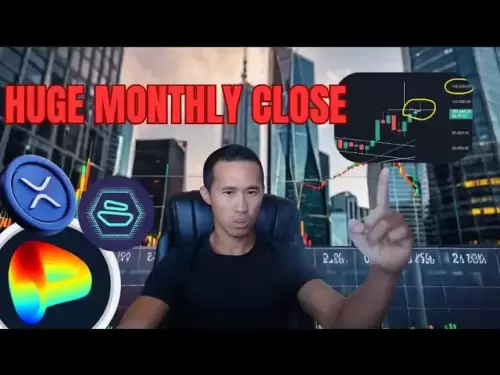-
 Bitcoin
Bitcoin $107,275.1551
-0.32% -
 Ethereum
Ethereum $2,485.3056
1.77% -
 Tether USDt
Tether USDt $1.0005
0.03% -
 XRP
XRP $2.2223
1.31% -
 BNB
BNB $657.7608
1.39% -
 Solana
Solana $156.3566
3.02% -
 USDC
USDC $0.9999
0.01% -
 TRON
TRON $0.2791
1.09% -
 Dogecoin
Dogecoin $0.1651
0.45% -
 Cardano
Cardano $0.5738
2.78% -
 Hyperliquid
Hyperliquid $40.2672
5.82% -
 Bitcoin Cash
Bitcoin Cash $517.5487
5.30% -
 Sui
Sui $2.7981
-0.40% -
 Chainlink
Chainlink $13.3500
-0.36% -
 UNUS SED LEO
UNUS SED LEO $9.1220
1.12% -
 Avalanche
Avalanche $17.9515
-0.32% -
 Stellar
Stellar $0.2361
-0.44% -
 Toncoin
Toncoin $2.9423
2.33% -
 Shiba Inu
Shiba Inu $0.0...01145
-0.68% -
 Litecoin
Litecoin $86.1693
-0.63% -
 Hedera
Hedera $0.1493
0.64% -
 Monero
Monero $315.1374
1.81% -
 Polkadot
Polkadot $3.4002
-0.73% -
 Dai
Dai $1.0001
0.03% -
 Bitget Token
Bitget Token $4.5413
-1.35% -
 Ethena USDe
Ethena USDe $1.0002
-0.01% -
 Uniswap
Uniswap $7.1733
-0.57% -
 Aave
Aave $274.0465
-0.23% -
 Pepe
Pepe $0.0...09810
2.24% -
 Pi
Pi $0.5101
-3.10%
How to reduce the risk of SOL leveraged trading?
Mitigate SOL leveraged trading risks by using stop-loss orders, diversifying assets, employing gradual entry/exit strategies, choosing a reputable exchange, and consistently monitoring market volatility & news. Thorough research and risk management are crucial.
Mar 13, 2025 at 08:46 pm

Key Points:
- Understanding Leverage and its Risks in SOL Trading
- Choosing a Reputable Exchange
- Utilizing Risk Management Tools
- Diversification and Position Sizing
- Monitoring Market Volatility and News
- Employing Stop-Loss Orders
- Gradual Entry and Exit Strategies
- Backtesting and Paper Trading
- Staying Informed and Educated
How to Reduce the Risk of SOL Leveraged Trading?
Leveraged trading, while offering the potential for high returns in cryptocurrencies like Solana (SOL), significantly amplifies both profits and losses. Understanding and mitigating the inherent risks is crucial for successful and sustainable trading. This article explores strategies to reduce risk when engaging in leveraged SOL trading.
Understanding Leverage and its Risks in SOL Trading
Leverage allows traders to control a larger position than their initial capital permits. For example, 5x leverage means controlling $5 worth of SOL for every $1 invested. While this magnifies potential profits, it equally magnifies losses. A small market movement against your position can lead to significant losses, potentially exceeding your initial investment. This is called liquidation.
Choosing a Reputable Exchange
Selecting a secure and reliable exchange is paramount. Reputable exchanges typically have robust security measures, transparent fee structures, and reliable order execution. Researching and comparing exchanges based on user reviews, security protocols, and regulatory compliance is essential before trading.
Utilizing Risk Management Tools
Many exchanges offer risk management tools like stop-loss orders and trailing stop-loss orders. A stop-loss order automatically sells your position when the price drops to a predetermined level, limiting potential losses. A trailing stop-loss order follows the price as it rises, protecting profits while still allowing for upward movement.
Diversification and Position Sizing
Don't put all your eggs in one basket. Diversify your portfolio across different cryptocurrencies to reduce the impact of a single asset's price fluctuation. Similarly, position sizing is critical. Never invest more than you can afford to lose in a single trade, regardless of leverage used.
Monitoring Market Volatility and News
The cryptocurrency market is highly volatile. Stay informed about market trends, news events, and regulatory developments that could impact SOL's price. Understanding these factors can help you make more informed trading decisions and anticipate potential risks.
Employing Stop-Loss Orders
Stop-loss orders are your first line of defense against substantial losses. Set them strategically, considering both your risk tolerance and the volatility of the market. Regularly review and adjust your stop-loss orders as the market conditions change.
Gradual Entry and Exit Strategies
Avoid placing large leveraged positions all at once. Instead, consider a gradual entry strategy, spreading your position across multiple trades. This reduces the impact of a sudden price drop. Similarly, a gradual exit strategy can help lock in profits while minimizing risk.
Backtesting and Paper Trading
Before risking real capital, practice with a demo account or through paper trading. This allows you to test your strategies and risk management techniques without the financial consequences of real trading. Backtesting historical data can also help refine your approach.
Staying Informed and Educated
Continuously learn about cryptocurrency trading, leverage, and risk management. Stay updated on market analysis, technical indicators, and fundamental factors that affect SOL's price. Understanding these elements empowers you to make better-informed decisions.
Common Questions:
Q: What is liquidation in leveraged trading?
A: Liquidation occurs when the value of your leveraged position falls below the exchange's maintenance margin requirement. The exchange automatically sells your assets to cover the losses, resulting in a complete loss of your initial investment.
Q: How does leverage affect my potential profits and losses?
A: Leverage amplifies both. A 5x leveraged position means a 10% price increase yields a 50% profit, but a 10% decrease results in a 50% loss.
Q: What are the benefits of using stop-loss orders?
A: Stop-loss orders automatically sell your position when the price drops to a specified level, limiting potential losses and protecting your capital from significant market downturns.
Q: How can I diversify my SOL leveraged trading?
A: Diversification involves spreading your investments across multiple cryptocurrencies instead of concentrating solely on SOL. This reduces the risk associated with the volatility of a single asset.
Q: Is it possible to reduce risk completely in leveraged trading?
A: No, leveraged trading inherently carries significant risk. However, by employing the strategies discussed, you can substantially mitigate these risks and increase the probability of successful trading.
Q: What is the role of a reputable exchange in reducing risk?
A: A reputable exchange provides security, transparency, and reliable order execution. This reduces the risk of fraud, hacking, or unexpected platform failures, all of which can negatively impact your trading experience.
Q: How does backtesting help in reducing risk?
A: Backtesting allows you to simulate your trading strategies using historical data. This helps identify weaknesses in your approach and allows for adjustments before risking real capital.
Q: What are the risks associated with high leverage?
A: High leverage significantly amplifies both profits and losses. A small market movement against your position can lead to rapid and substantial losses, potentially resulting in liquidation and the complete loss of your initial investment.
Disclaimer:info@kdj.com
The information provided is not trading advice. kdj.com does not assume any responsibility for any investments made based on the information provided in this article. Cryptocurrencies are highly volatile and it is highly recommended that you invest with caution after thorough research!
If you believe that the content used on this website infringes your copyright, please contact us immediately (info@kdj.com) and we will delete it promptly.
- Coinbase, Altcoins, and Listings: What's the Buzz?
- 2025-07-01 00:30:11
- Chainlink's Bullish Signals: Investors Bet on Long-Term Value
- 2025-07-01 00:50:12
- CICADA Finance Soars on BNB Chain: A TGE Deep Dive
- 2025-07-01 01:30:11
- MicroStrategy's Bitcoin Bet: Holdings, Sell-Off Concerns, and S&P 500 Dreams
- 2025-07-01 01:30:11
- XRPL EVM Sidechain: Ethereum dApps Unleashed on XRP Ledger!
- 2025-07-01 01:35:11
- Bybit, Kraken, and Tokenized Stocks: A New Era for Trading?
- 2025-07-01 00:30:11
Related knowledge

How to customize USDT TRC20 mining fees? Flexible adjustment tutorial
Jun 13,2025 at 01:42am
Understanding USDT TRC20 Mining FeesMining fees on the TRON (TRC20) network are essential for processing transactions. Unlike Bitcoin or Ethereum, where miners directly validate transactions, TRON uses a delegated proof-of-stake (DPoS) mechanism. However, users still need to pay bandwidth and energy fees, which are collectively referred to as 'mining fe...

USDT TRC20 transaction is stuck? Solution summary
Jun 14,2025 at 11:15pm
Understanding USDT TRC20 TransactionsWhen users mention that a USDT TRC20 transaction is stuck, they typically refer to a situation where the transfer of Tether (USDT) on the TRON blockchain has not been confirmed for an extended period. This issue may arise due to various reasons such as network congestion, insufficient transaction fees, or wallet-rela...

How to cancel USDT TRC20 unconfirmed transactions? Operation guide
Jun 13,2025 at 11:01pm
Understanding USDT TRC20 Unconfirmed TransactionsWhen dealing with USDT TRC20 transactions, it’s crucial to understand what an unconfirmed transaction means. An unconfirmed transaction is one that has been broadcasted to the blockchain network but hasn’t yet been included in a block. This typically occurs due to low transaction fees or network congestio...

How to check USDT TRC20 balance? Introduction to multiple query methods
Jun 21,2025 at 02:42am
Understanding USDT TRC20 and Its ImportanceUSDT (Tether) is one of the most widely used stablecoins in the cryptocurrency market. It exists on multiple blockchain networks, including TRC20, which operates on the Tron (TRX) network. Checking your USDT TRC20 balance accurately is crucial for users who hold or transact with this asset. Whether you're sendi...

What to do if USDT TRC20 transfers are congested? Speed up trading skills
Jun 13,2025 at 09:56am
Understanding USDT TRC20 Transfer CongestionWhen transferring USDT TRC20, users may occasionally experience delays or congestion. This typically occurs due to network overload on the TRON blockchain, which hosts the TRC20 version of Tether. Unlike the ERC20 variant (which runs on Ethereum), TRC20 transactions are generally faster and cheaper, but during...

The relationship between USDT TRC20 and TRON chain: technical background analysis
Jun 12,2025 at 01:28pm
What is USDT TRC20?USDT TRC20 refers to the Tether (USDT) token issued on the TRON blockchain using the TRC-20 standard. Unlike the more commonly known ERC-20 version of USDT (which runs on Ethereum), the TRC-20 variant leverages the TRON network's infrastructure for faster and cheaper transactions. The emergence of this version came as part of Tether’s...

How to customize USDT TRC20 mining fees? Flexible adjustment tutorial
Jun 13,2025 at 01:42am
Understanding USDT TRC20 Mining FeesMining fees on the TRON (TRC20) network are essential for processing transactions. Unlike Bitcoin or Ethereum, where miners directly validate transactions, TRON uses a delegated proof-of-stake (DPoS) mechanism. However, users still need to pay bandwidth and energy fees, which are collectively referred to as 'mining fe...

USDT TRC20 transaction is stuck? Solution summary
Jun 14,2025 at 11:15pm
Understanding USDT TRC20 TransactionsWhen users mention that a USDT TRC20 transaction is stuck, they typically refer to a situation where the transfer of Tether (USDT) on the TRON blockchain has not been confirmed for an extended period. This issue may arise due to various reasons such as network congestion, insufficient transaction fees, or wallet-rela...

How to cancel USDT TRC20 unconfirmed transactions? Operation guide
Jun 13,2025 at 11:01pm
Understanding USDT TRC20 Unconfirmed TransactionsWhen dealing with USDT TRC20 transactions, it’s crucial to understand what an unconfirmed transaction means. An unconfirmed transaction is one that has been broadcasted to the blockchain network but hasn’t yet been included in a block. This typically occurs due to low transaction fees or network congestio...

How to check USDT TRC20 balance? Introduction to multiple query methods
Jun 21,2025 at 02:42am
Understanding USDT TRC20 and Its ImportanceUSDT (Tether) is one of the most widely used stablecoins in the cryptocurrency market. It exists on multiple blockchain networks, including TRC20, which operates on the Tron (TRX) network. Checking your USDT TRC20 balance accurately is crucial for users who hold or transact with this asset. Whether you're sendi...

What to do if USDT TRC20 transfers are congested? Speed up trading skills
Jun 13,2025 at 09:56am
Understanding USDT TRC20 Transfer CongestionWhen transferring USDT TRC20, users may occasionally experience delays or congestion. This typically occurs due to network overload on the TRON blockchain, which hosts the TRC20 version of Tether. Unlike the ERC20 variant (which runs on Ethereum), TRC20 transactions are generally faster and cheaper, but during...

The relationship between USDT TRC20 and TRON chain: technical background analysis
Jun 12,2025 at 01:28pm
What is USDT TRC20?USDT TRC20 refers to the Tether (USDT) token issued on the TRON blockchain using the TRC-20 standard. Unlike the more commonly known ERC-20 version of USDT (which runs on Ethereum), the TRC-20 variant leverages the TRON network's infrastructure for faster and cheaper transactions. The emergence of this version came as part of Tether’s...
See all articles

























































































